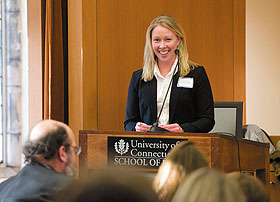  |
| HOME | THIS ISSUE | CALENDAR | GRANTS | BACK ISSUES | < BACK | NEXT > |
School of Law panel discusses causes of prison overcrowdingby Michael Kirk - February 17, 2009
|
||||
| In 1977, Connecticut had roughly 4,000 of its citizens incarcerated. Today, that number is about 19,000. And nationwide, more than 2.3 million people are in prison, more than in any other nation in the world, including Russia and China. The explosion in the American prison population in the past 40 years and what can be done about it was the subject of a day-long symposium at the Law School, “The Road to Prison Reform: Treating the Causes and Conditions of our Overburdened System.” The Feb. 6 event was sponsored by the Connecticut Public Interest law Journal. Rapid growth Incarceration is also expensive, he said: it costs governments about $24,000 per prisoner per year – a heavy burden on state budgets. Added to that, Orland said, within these statistics there is a “glaring, clear racial component,” with the percentage of black and Hispanic prisoners many times larger than their percentage in the overall population. The first panel, “Courthouse to Jailhouse: The Legal Causes of Overcrowding,” featured William Carbone, executive director of court support services for the state’s judicial department, and law professors Steven Duke of Yale Law School and Brian Foley of Boston University. The speakers said the increase in the prison population can be blamed on several factors: the dramatic increase in drug arrests beginning in the 1970s (20 percent of the prison population are there for drug offenses, including half of all federal prisoners); the curtailment of parole; the enactment of “truth in sentencing” laws that mandate prisoners serve their full sentence; the elimination of good behavior programs that used to allow prisoners to earn an earlier release; and reduction in the amount of discretion judges have in sentencing, owing to the establishment of mandatory minimum sentences for certain crimes. Foley said one problem is that a defendant’s background, personal situation, and the reasons why he or she committed a particular crime are not fully considered at the time of sentencing. “Causes and motives are not reflected in laws,” said Foley. “We’re jailing many people who do not need jailing.” Foley said prisoners are not treated as human beings, sometimes being packed into small cells four at a time. This, he said, combined with a lack of adequate support when a sentence concludes, makes reentering the world from prison very difficult.
When it comes to sentencing, Foley said, the nation needs to “rethink the idea of using prison promiscuously.” Duke, the Yale professor, drew a direct connection between the massive prison population and the “war on drugs,” which began in the early 1970s when the prison population was a tiny fraction of today’s. He said “it is not the use of drugs that causes crime, it’s the prohibition.” The risks posed to drug dealers and users by aggressive law enforcement increases the cost of drugs, and the high cost leads addicts to go to great lengths to obtain drugs, including committing theft and property crimes, he said. He took particular aim at laws relating to marijuana. Duke said it is unheard of to overdose on marijuana, and violence is not typically associated with its use. “It is mindless for us to put people in jail for using marijuana,” he said. When it comes to drug offenders, Duke pointed to several studies that show treatment is effective for many people in prison for drug-related crimes. There are no studies to the contrary, he added. Reducing recidivism Why, then, is there more emphasis on incarceration than on treatment for drug offenders? And why did government move to change laws and programs, leading to an explosion in the prison population? Duke suggested public attitudes have something to do with it. He said he detected a change in the American mindset, beginning in the early 1980’s, as the public demanded a tougher stand on crime and harsher sentences for offenders. This led state legislatures and Congress to enact tougher penalties and longer sentences, and reduce judicial discretion. Other panels during the day examined social causes and implications, and prisoners’ rights and system reform. |
| ADVANCE HOME UCONN HOME |

